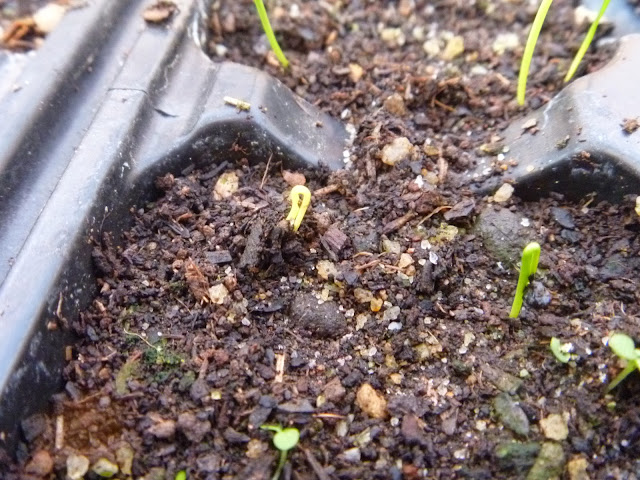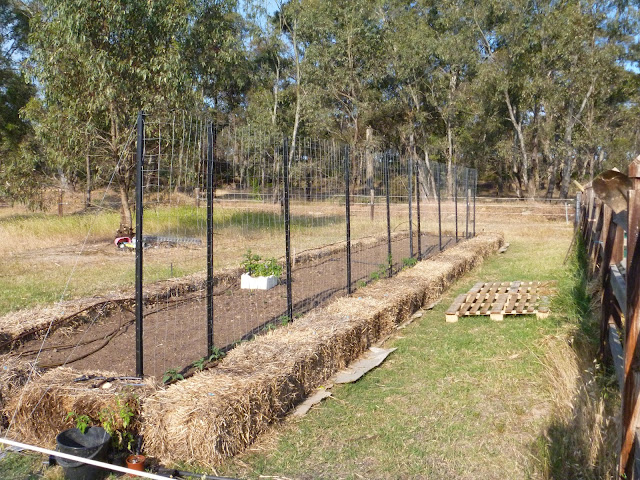|
|
Post by kevin8715 on Apr 14, 2014 10:56:01 GMT -5
Do you plan on collecting seed? I would be interested in TPOS. I already have 7 seedlings fron Kellys but the more the better.
|
|
|
|
Post by billw on Apr 14, 2014 11:20:41 GMT -5
Yes. Usually, they flower at inconvenient times and end up getting soaked before the seed is ready. This year, it looks like they will produce seed during the dry(ish) season. If they all produce, I should have plenty to share.
Interestingly, no indication of flowering in any of the KW varieties - only the standard yellow potato onions are flowering.
|
|
|
|
Post by templeton on Apr 14, 2014 16:24:34 GMT -5
Here's a pic of my germinating Green Mountain F2 seed. Note the yellow color of seedlings front left and back right. Last generation i got a couple of these yellowish plants to advanced seedlings, but they didn't do well in the garden, and eventually succumbed. Anyone else notice this with Green mountain seedlings? Am about to do an autumn planting of the F1 bulbs at my second garden, which is subject to frost. Will they do OK? T  |
|
|
|
Post by philagardener on Apr 14, 2014 20:34:49 GMT -5
I started some of KW's O.P. seed this year and the seedlings all seemed green with range of vigor. I hardened them off and just planted them out in the garden this afternoon.
|
|
|
|
Post by oxbowfarm on Apr 14, 2014 20:49:17 GMT -5
I grew some of Kelly's seed last year, I did not notice any significant issues with yellow/chlorotic seedlings, but I see that occasionally with other onion seed too. Usually they die before they put out the second leaf. I lost most of the seedlings I started from Kelly's seed. there was only two plants that made it to be planted out, and only one of those survived storage to be planted out. But it is doing well, very yellow skin unlike Green Mountain. I also have tray of Green Mountain seed from seed I grew out in 2013 coming along. It will be planted out in a few weeks.
|
|
|
|
Post by nicollas on Apr 15, 2014 2:34:08 GMT -5
Last year green mountain put seed talk, and my other PO (german brown) where planted side by side and flowered too (and i suspect that is uncommon, but have grown them just for two years). It could have been some environmental factor that made both flowered, but maybe root/chemical communication had occurred ? It seems fair to suspect that there is a evolutive advantage to coordinate flowering for cross pollination between onions of the same area ? So i suggest to plant flowering cultivars near non flowering ones to try to trigger flowering in both ? sadly i've lost of my flower stalk of the two cultivar due to slug and mismanagement ...
|
|
|
|
Post by richardw on Apr 16, 2014 0:46:23 GMT -5
I had no yellow green mountain seedlings when i sowed a batch of seed,like you T,ive planted out where it will be subjected to frost also,ive heard that TPOS is as tough as tree onions so i dont have concerns about it
|
|
|
|
Post by templeton on Apr 16, 2014 2:57:10 GMT -5
I'm going to do a 'plant to row' growout of the Green Mountain F1s. This will be an autumn planting - proabably a bit different to NH autumn plantings since we don't get feet of snow - actually no snow at all, and frosts only get down to a few degrees below freezing, and never freeze the soil.
Kelly and some others mention different plant responses to autumn and spring plantings - not sure if they would show up here, but I'm not likely to find out since I will planting everything in the next week or so. I haven't the time, space or mental concentration to do an autumn/spring comparison at the moment.
Since I will be planting into a wide raised bed that is growing a snow pea trial down one long edge, does anyone have any advice about how close I can plant onions to the peas before I get negative interactions?
T
|
|
|
|
Post by mjc on Apr 16, 2014 6:39:09 GMT -5
Since I will be planting into a wide raised bed that is growing a snow pea trial down one long edge, does anyone have any advice about how close I can plant onions to the peas before I get negative interactions? T Most of the time, for things like that, the rule of thumb is the drip line, but that's mostly for trees or bushy plants. Not sure what it would be for vining plants like peas. I'm assuming that you aren't letting them sprawl. And peas tend to have 'narrow'/non-spreading roots, anyway. They tend to go deeper than wider. Onions pretty much have their roots no wider than the bulb. but sometimes will go as wide as the spread of the leaves. Just how wide is the bed? |
|
|
|
Post by templeton on Apr 16, 2014 17:47:52 GMT -5
Thanks for the reply, MJC. The bed is about 2 metres (6 feet) wide, with the pea trellis down one side, about 20 cm (9 inches)in from the edge.  T |
|
|
|
Post by mjc on Apr 16, 2014 18:03:59 GMT -5
Growing them on the other side would be about a meter....that should be enough. Especially if you plant something like spinach down the middle (spinach is listed as beneficial to both onions and peas, so are celery and carrots). Here's a nice companion chart. www.mysquarefootgarden.net/companion-planting/ |
|
|
|
Post by templeton on Apr 16, 2014 19:21:59 GMT -5
Yeah, I was thinking of a lettuce trial between, but spinach is a good idea. Ms. T will be pleased.
T
|
|
|
|
Post by kevin8715 on Apr 16, 2014 19:46:38 GMT -5
A bit off topic but has anyone's true shallots flowered? I have 2 types, a generic one and holland red, and would like to cross them with potato onions. I have a similar goal to Kelly in his book of longer storing and stronger flavor shallots and vice versa.
|
|
|
|
Post by mjc on Apr 16, 2014 20:41:29 GMT -5
Years ago, I had one flower...but it must not have made viable seed, because none ever sprouted. Chances of a single flower producing viable seed are slim to none, as found I out later.
Did you grab that paper, Kelly references in his book?
|
|
|
|
Post by kevin8715 on Apr 16, 2014 20:55:55 GMT -5
German one right? I read Kelly's summary but not the actual paper. Will give it a quick look through.
|
|